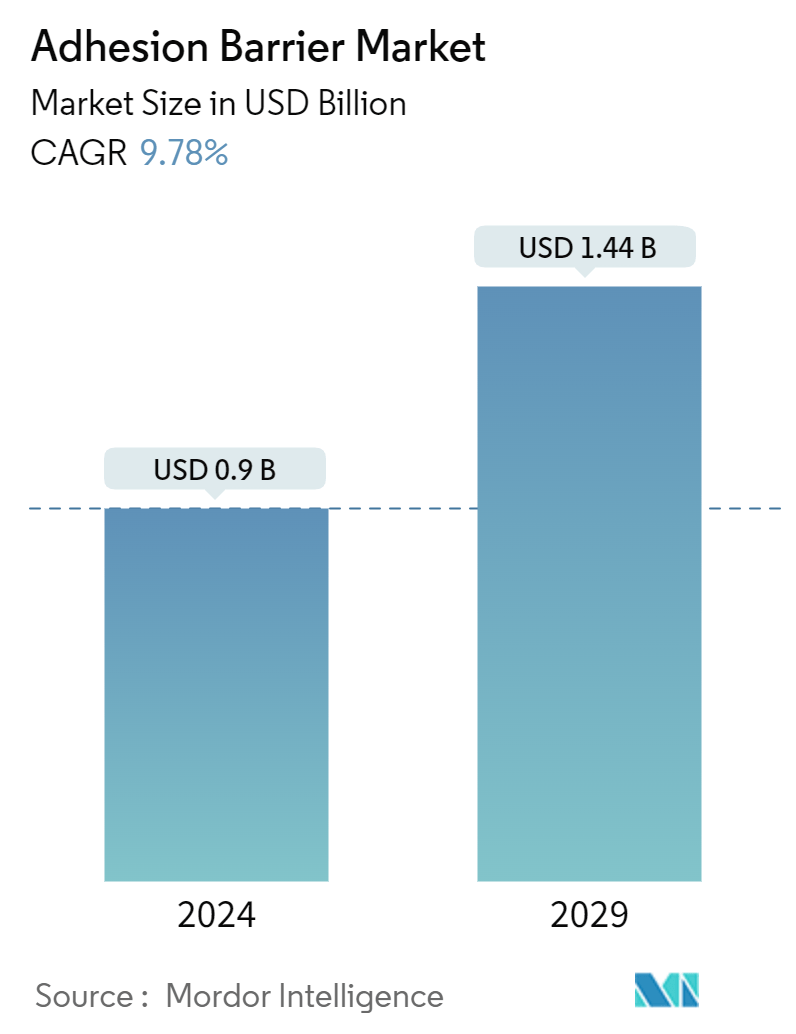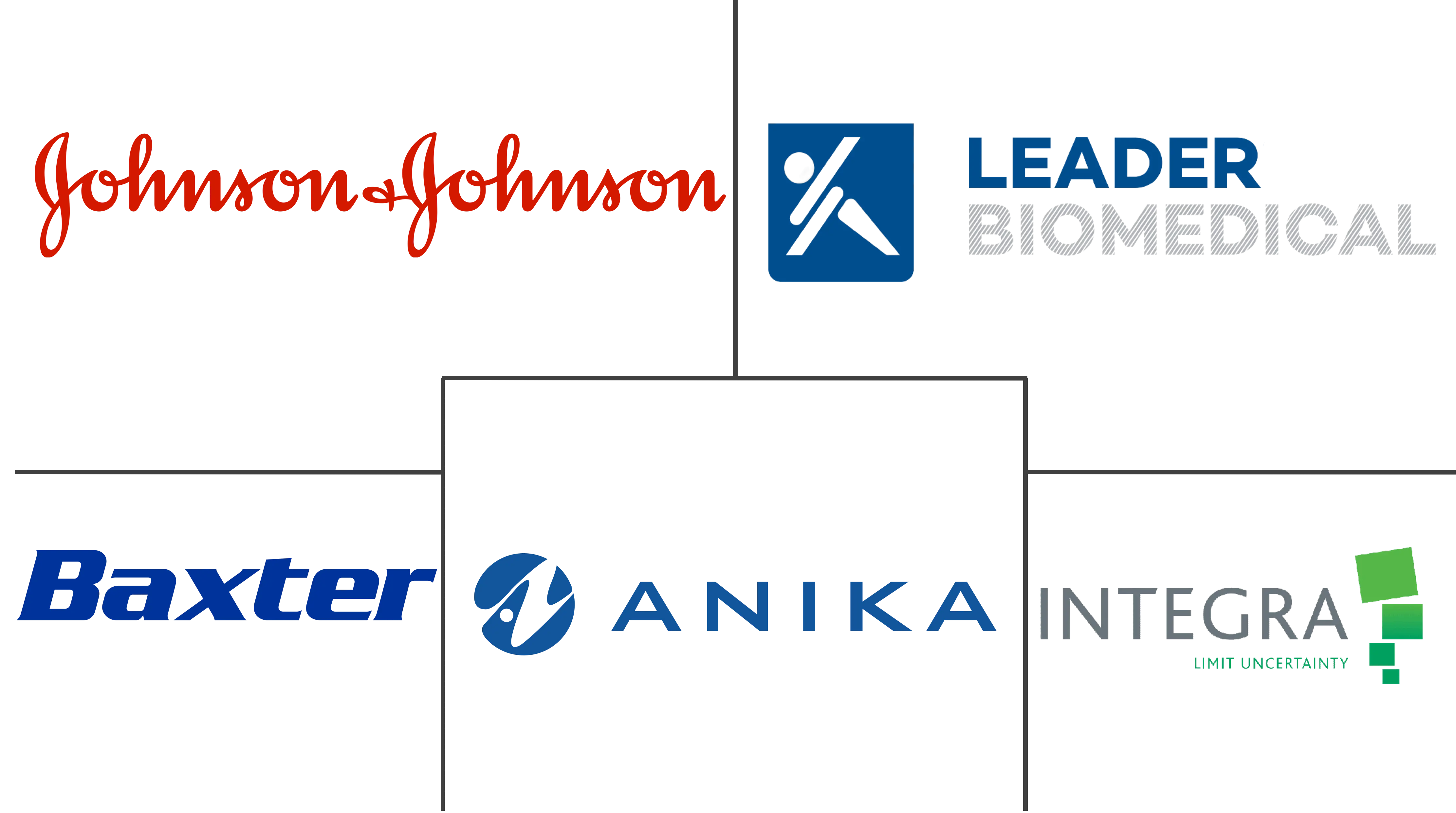Market Size of Adhesion Barrier Industry

| Study Period | 2019 - 2029 |
| Market Size (2024) | USD 0.9 Billion |
| Market Size (2029) | USD 1.44 Billion |
| CAGR (2024 - 2029) | 9.78 % |
| Fastest Growing Market | Asia Pacific |
| Largest Market | North America |
Major Players
*Disclaimer: Major Players sorted in no particular order |
Adhesion Barrier Market Analysis
The Adhesion Barrier Market size is estimated at USD 0.9 billion in 2024, and is expected to reach USD 1.44 billion by 2029, growing at a CAGR of 9.78% during the forecast period (2024-2029).
The pandemic had a significant impact on various surgical procedures initially, as there were strict guidelines specific to each specialty that was implemented and followed by surgeons to continue to provide safe and effective care to their patients during the COVID-19 pandemic. For instance, according to an article published by BMJ Journal in June 2021, surgical programs suspended various non-urgent or elective surgical procedures worldwide during the pandemic. These changes considerably impacted patients, providers, and healthcare organizations. Thus, reducing surgical procedures during the COVID-19 pandemic negatively impacted the market's growth in 2020. However, the postponed surgeries resumed during the post-pandemic period, which boosted the market's growth. As the pandemic has subsided, the studied market is expected to grow significantly over the forecast period. Specific factors driving the market growth include increased surgeries and sports-related injuries and rising awareness about the medical implications of adhesions.
According to the data published by British Heart Foundation in December 2021, an estimated 32,938 completed heart operations and other heart procedures were performed in England in October 2021. As adhesion barriers are used after surgeries, increasing operations and surgeries are expected to require adhesion barriers to reduce scars. Therefore, the market is expected to surge over the forecast period.
Moreover, a growing number of surgical procedures due to sports injuries, accidents, and orthopedic surgeries are primary factors driving the adhesion barrier market. There is a high prevalence of orthopedic diseases and other chronic conditions where surgery is suggested as mandatory. According to the data published by the National Safety Council (NSC) for the United States in 2021, bicycling accounted for about 375,797 injuries, and exercise accounted for about 409,224 injuries. The injuries due to an all-terrain vehicle (ATV), moped, and minibike were 238,404, and those due to skateboard, scooter, and hoverboard were 245,177. Therefore, an increasing number of injuries is expected to propel the growth of the adhesion barrier market globally.
Healthcare in developing countries is undergoing rapid changes. The growing population in these countries will likely lead to increased demand for medical devices. The growing burden of diseases and innovative medical treatments contributed to nearly two-thirds of the rise in spending. Spending on healthcare in developing countries is expected to increase during the forecast period. According to the data published by the Office for National Statistics of the United Kingdom in May 2022, the estimated total healthcare expenditure in 2021 was GBP 277 billion (USD 373.4 billion), which increased by 7.4% when compared to the spending in the last year. Specific investments in the healthcare sector offer attractive long-term financial benefits. Medical care is one area where individuals tend to increase spending as incomes grow. Hence, with the increasing healthcare expenditure, the adoption of advanced products, such as adhesion barriers for surgeries, is expected to increase. Thus the studied market is expected to experience growth during the forecast period of the study.
Therefore, due to the aforementioned factors, such as the increased volume of surgeries and sports-related injuries, increasing healthcare expenditure, and rising awareness about the medical implications of adhesions, the studied market is expected to experience growth. However, the high cost of surgical procedures coupled with side effects associated with adhesion barriers and stringent regulations resulting in limited technological innovations are expected to restrain the growth of the adhesion barrier market.
Adhesion Barrier Industry Segmentation
An adhesion barrier refers to a medical implant that can be used to reduce abnormal internal scarring by adhesions following any surgery by separating the internal tissues and organs as long as they heal. It involves a proper surgical technique which is very much crucial to diminish adhesion formation.
The Adhesion Barrier Market is Segmented by Product (Synthetic Adhesion Barriers (Hyaluronic Acid, Regenerated Cellulose, Polyethylene Glycol, and Other Synthetic Adhesion Barriers) and Natural Adhesion Barriers (Collagen and Fibrin)), Formulation (Film, Liquid, and Gel), Application (General/Abdominal Surgeries, Gynecological Surgeries, Cardiovascular Surgeries, Orthopedic Surgeries, Neurological Surgeries, and Other Applications), and Geography (North America, Europe, Asia-Pacific, Middle East and Africa, and South America). The market report also covers the estimated market sizes and trends for 17 different countries across major regions globally. The report offers the value (in USD million) for the above segments.
| By Product | ||||||
| ||||||
|
| By Formulation | |
| Film | |
| Liquid | |
| Gel |
| By Application | |
| General/Abdominal Surgeries | |
| Gynecological Surgeries | |
| Cardiovascular Surgeries | |
| Orthopedic Surgeries | |
| Neurological Surgeries | |
| Other Applications |
| By Geography | ||||||||
| ||||||||
| ||||||||
| ||||||||
| ||||||||
|
Adhesion Barrier Market Size Summary
The adhesion barrier market is poised for significant growth over the forecast period, driven by an increase in surgical procedures and a rising awareness of the medical implications of adhesions. The market experienced a temporary setback during the COVID-19 pandemic due to the suspension of non-urgent surgeries, but has since rebounded as postponed procedures resumed. Factors such as the growing incidence of sports-related injuries, orthopedic surgeries, and the rising prevalence of chronic conditions requiring surgical intervention are contributing to the market's expansion. Additionally, the increasing healthcare expenditure in developing countries is expected to further propel the adoption of adhesion barriers, as these advanced medical devices become more accessible.
In North America, the market growth is supported by technological advancements, an aging population requiring complex surgeries, and favorable reimbursement models. The rising number of orthopedic procedures, such as hip and knee arthroplasties, along with the increasing rate of cesarean sections, are expected to drive the demand for adhesion barriers. The market is moderately competitive, with key players like Johnson & Johnson, Baxter International, and Integra LifeSciences Holdings Corporation holding substantial shares. Recent product launches, such as CGBIO's MEDICLORE in Indonesia and Gunze Limited's TENALEAF in Japan, highlight ongoing innovations in the field. Despite challenges like high surgical costs and regulatory hurdles, the market is anticipated to experience robust growth due to the increasing need for effective adhesion prevention solutions in various surgical contexts.
Adhesion Barrier Market Size - Table of Contents
-
1. MARKET DYNAMICS
-
1.1 Market Overview
-
1.2 Market Drivers
-
1.2.1 Increase in the Volume of Surgeries and Sports-related Injuries
-
1.2.2 Rising Awareness about the Medical Implications of Adhesions
-
-
1.3 Market Restraints
-
1.3.1 High Cost of Surgical Procedures Coupled with Side Effects Associated with Adhesion Barriers
-
1.3.2 Stringent Regulations Resulting in Limited Technological Innovations
-
-
1.4 Industry Attractiveness - Porter's Five Forces Analysis
-
1.4.1 Threat of New Entrants
-
1.4.2 Bargaining Power of Buyers
-
1.4.3 Bargaining Power of Suppliers
-
1.4.4 Threat of Substitute Products
-
1.4.5 Intensity of Competitive Rivalry
-
-
-
2. MARKET SEGMENTATION (Market Size by Value - USD Million)
-
2.1 By Product
-
2.1.1 Synthetic Adhesion Barriers
-
2.1.1.1 Hyaluronic Acid
-
2.1.1.2 Regenerated Cellulose
-
2.1.1.3 Polyethylene Glycol
-
2.1.1.4 Other Synthetic Adhesion Barriers
-
-
2.1.2 Natural Adhesion Barriers
-
2.1.2.1 Collagen
-
2.1.2.2 Fibrin
-
-
-
2.2 By Formulation
-
2.2.1 Film
-
2.2.2 Liquid
-
2.2.3 Gel
-
-
2.3 By Application
-
2.3.1 General/Abdominal Surgeries
-
2.3.2 Gynecological Surgeries
-
2.3.3 Cardiovascular Surgeries
-
2.3.4 Orthopedic Surgeries
-
2.3.5 Neurological Surgeries
-
2.3.6 Other Applications
-
-
2.4 By Geography
-
2.4.1 North America
-
2.4.1.1 United States
-
2.4.1.2 Canada
-
2.4.1.3 Mexico
-
-
2.4.2 Europe
-
2.4.2.1 Germany
-
2.4.2.2 United Kingdom
-
2.4.2.3 France
-
2.4.2.4 Italy
-
2.4.2.5 Spain
-
2.4.2.6 Rest of Europe
-
-
2.4.3 Asia-Pacific
-
2.4.3.1 China
-
2.4.3.2 Japan
-
2.4.3.3 India
-
2.4.3.4 Australia
-
2.4.3.5 South korea
-
2.4.3.6 Rest of Asia-Pacific
-
-
2.4.4 Middle East and Africa
-
2.4.4.1 GCC
-
2.4.4.2 South Africa
-
2.4.4.3 Rest of Middle East and Africa
-
-
2.4.5 South America
-
2.4.5.1 Brazil
-
2.4.5.2 Argentina
-
2.4.5.3 Rest of South America
-
-
-
Adhesion Barrier Market Size FAQs
How big is the Adhesion Barrier Market?
The Adhesion Barrier Market size is expected to reach USD 0.9 billion in 2024 and grow at a CAGR of 9.78% to reach USD 1.44 billion by 2029.
What is the current Adhesion Barrier Market size?
In 2024, the Adhesion Barrier Market size is expected to reach USD 0.9 billion.

